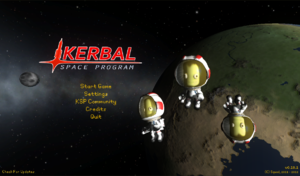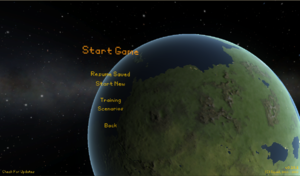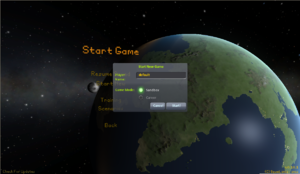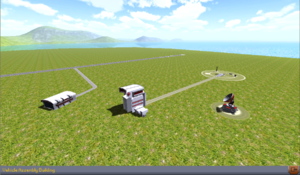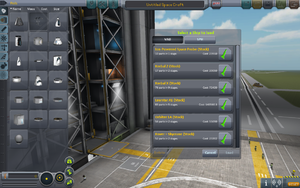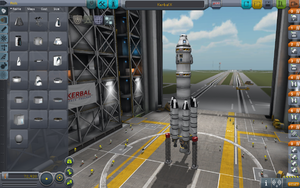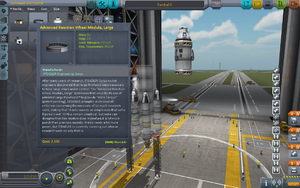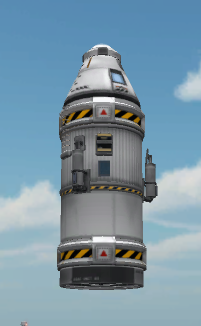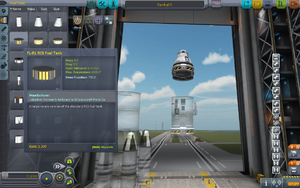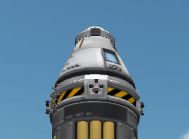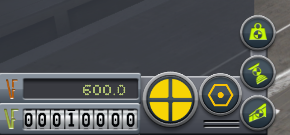Difference between revisions of "Getting Started/cs"
(→Spouštění hry) |
(→Spouštění hry) |
||
| Line 28: | Line 28: | ||
#*# Vy už víte co máte dělat. | #*# Vy už víte co máte dělat. | ||
| − | == Spouštění hry == | + | == Spouštění hry ==Jakmile hru nainstalujete, můžete ji spustit. Tak můžete učinit spuštěním KSP.exe ze složky, kde máte hru rozbalenou (KSP.app na OSX, KSP.x86_64 nebo KSP.x86 na Linuxu - záleží, jestli chcete hru spastic v 64 nebo 32bit verzi). Můžete si i udělat zástupce ikony na vaši plochu, čímž si spouštění hry pro příště usnadníte (nebude fungovat, pokud budete hru spouštět z USB disku z různých počítačů).[[File:MainScreen.png|thumbnail|center|Obrázek 1 : KSP v0.18.1 Hlavní obrazovka]]Hlavní obrazovka obsahuje následující položky:# Start Game - Spustit hru# Settings - Nastavení (Zde si můžete upravit vlastnosti hry jako například kvalitu grafiky)# KSP Community - KSP komunita# Credits - Autoři (Zde uvidíte, kdo vytvořil Kerbal Space Program)# Quit - Ukončit (Tímto hru ukončíte)Zvolením položky Start Game se ukáže další menu s položkami jako Start (Spustit) a Load (Načíst) Game.[[File:StartGameMenu.png|thumbnail|center|Obrázek 2: Start / Resume Game Menu (Spustit / Pokračovat ve hře)]]Při spouštění nové hry je jméno vašeho budoucího uložení pojmenováno 'default'. Přejmenujte si to na cokoliv vás napadne.[[File:NewGame.png|thumbnail|center|Obrázek 3 : Okno s volbou nové hry]]Jakmile hru prvně spustíte, objevíte se na Odpalovacím středisku (Launch Compound). Zde naleznete dvě montážní střediska (assembly bays), sledovací stanici (tracking station) a odpalovací plochu (launch pad). |
| − | |||
| − | |||
| − | [[File:MainScreen.png|thumbnail|center| | ||
| − | |||
| − | |||
| − | # Start Game | ||
| − | # Settings ( | ||
| − | # KSP Community | ||
| − | # Credits ( | ||
| − | # Quit ( | ||
| − | |||
| − | |||
| − | |||
| − | [[File:StartGameMenu.png|thumbnail|center| | ||
| − | |||
| − | |||
| − | |||
| − | [[File:NewGame.png|thumbnail|center| | ||
| − | |||
| − | |||
== The Rocket! == | == The Rocket! == | ||
Revision as of 09:15, 22 July 2013
Tento návod vás provede prvními pár hodinami v Kerbal Space Program. I když není příliš obsáhlý, měl by vám poskytnout vcelku slušný přehled o základech.
Contents
[hide]Nákup hry
Squad umožňuje KSP zakoupit vcelku jednoduše.
- Navštivte http://kerbalspaceprogram.com
- Klikněte na obchod, měl by tam být označený program “Kerbal Space Program” tak jako program označený “Kerbalizer”, prozatím Kerbalizer ignorujte.
Případně můžete pořídit KSP skrze Steam
Stáhnutí
Prozatím je možné stahovat KSP pouze jednorázově. Už ale jsou plány pro Aktualizátor - Patcher. Steam verze toto zvládá sama automaticky.
- Jděte do obchodu.
- Přihlašte se pomocí svého uživatelského jména a hesla.
- Klikněte na tlačítko profilu.
- Sjeďte až dolů a zvolte odkazový text Zakoupené položky (Purchase Invoice).
- Stáhněte si verzi hry dle vašho operačního systému.
- Uživatelé Mac OS:
- Pokud je potřeba, nainstalujte Mono ze zabaleného .dmg souboru.
- Rozbalte soubor do prázdné složky.
- Ujistěte se, že povolíte "execute permission" v souboru Patcher.command.
- Uživatelé Windows:
- Pokud je potřeba, nainstalujte .NET Framework 4.0 nebo vyšší. (Nové verze Windows již mají v sobě.)
- ROzbalte soubor do Nová složka, která není v Program Files. Program jako je 7-zip se může hodit.
- Uživatelé Linuxu:
- Vy už víte co máte dělat.
- Uživatelé Mac OS:
The Rocket!
Since a rocket is needed, select the middle structure, it will say Vehicle Assembly Building. From here we will begin the first rocket using a stock rocket.
By selecting the Orange Folder in the top right section of the window, the menu shown in Figure 5 will appear. Find and select the Kerbal X (stock). This will load up the rocket, Kerbal X. This rocket is fairly simple and can easily achieve orbit around the planet. If you are using the demo version, Here is a simple rocket I made that has achieved orbit with more than enough fuel for the return to the planet.
While this rocket appears to be a bit complex, it is really simple and can easily be explained. On the right side of the screen, shown in Figure 6, there are orange folders that have numbers ranging from 0 to 8. These are the launch stages that your rocket has. Launch stages are different than your rocket stages as the stages that make up the launch stages are what the spacebar triggers with each press. Each stage has at least one icon inside of it. These are the events of that stage. The launch stages are thus:
- Rocket Launch Stage 8
- This is your initial launch stage
- There are a total of seven Liquid Fuel Thrusters that are activated on this stage
- Rocket Launch Stage 7
- This is the second launch stage
- This launch stage releases the support braces, TT18-A Launch Stability Enhancers, that are shown at the bottom of the Kerbal X Rocket (the open frame supports capped with the red cap)
- Rocket Launch Stage 6
- This, the third, launch stage releases two of the boosters from the main rocket
- This stage should only be triggered after the first set of two boosters are out of fuel
- There is an audible cue as well as a visual indicator when a rocket engine is out of fuel
- This, the third, launch stage releases two of the boosters from the main rocket
- Rocket Launch Stage 5
- After a short while two more engines will run out, and pressing the spacebar will activate this stage to release them off of the main rocket
- Again, only trigger this stage *after* two more engines have run out of fuel
- After a short while two more engines will run out, and pressing the spacebar will activate this stage to release them off of the main rocket
- Rocket Launch Stage 4
- This is the same as the previous two launch stages
- The main difference here is that this is the last set of the booster engines for this rocket
- This is the same as the previous two launch stages
- Rocket Launch Stage 3
- This is the end of the first stage of the rocket
- When the spacebar is pressed, the main engine that helped the boosters get the rocket into space will separate from the second stage of the rocket
- This is the end of the first stage of the rocket
- Rocket Launch Stage 2
- This stage starts up the smaller engine attached directly to the capsule
- Rocket Launch Stage 1
- This is the last stage before the parachute is opened
- Since this is the last stage that will release the last engine, it is suggested *not* to activate it until you are on the return trip towards the planet
- This is the last stage before the parachute is opened
- Rocket Launch Stage 0
- This is the absolute last stage that deploys the parachute when activated
That is the run down of the orange tabs on the right side of the screen. While there is nothing that really *needs* to be done to the Kerbal X Rocket, I strongly advise adding a couple of items that will make getting into orbit a bit easier.
Figure 7 shows the main rocket stage removed in preparation of the black SAS module, from the Control Tab, that will be added. To "break" the rocket in the correct place, simply point your mouse at the section below the separator ring, the black and yellow ring with the red square on it, and do a left-mouse-click (LMC) once. This selects the fuel cell that is underneath of the separator ring and everything below that section of the rocket. Then simply move it out of the way, *but not into the grey component selections on the left* or else it will be trashed, and do another LMC to place the rocket components there.
The SAS module will help greatly in keeping your rockets on course without much fuss from you. With the SAS added, a simple keypress, "t", after the rocket is moved out to the launchpad, will allow the rocket to stay almost perfectly centered while it is in flight. There are other concerns for keeping the rocket stable but those will be covered later.
In order to add the SAS module, do an LMC on the black SAS module, then move your cursor over to the rocket sections. There should now be the SAS module following your cursor, and if not simply go back and do another LMC to select the module again. With the module following your cursor, drag it to the base of the separator ring and you will see the SAS turn green when it is properly placed. Do one last LMC and the module will be placed underneath the separator as shown in Figure 8. The last step is to combine the lower section back onto the SAS module. This is done the same way as it was taken off, just in reverse.
Another SAS module can be added to the section directly underneath the capsule. Simply repeat the same process to the separator that is underneath the capsule. While adding the SAS to the Capsule section, adding some RCS Fuel, Figure 9, will also assist in keeping the rocket stable in flight, by pressing "r" to turn on the rocket in flight. The last step is to add some RCS Thrusters, which I added to the capsule separation ring, see Figure 10. To add these thrusters in any sort of symmetry, use the symmetry icon in the bottom left of the screen, see Figure 11. Each LMC on this indicator will cycle through all of the cloning options, ie 1 - 8 duplicates of whatever item you are placing.
Once the rocket is all attached together again, it is time to move the rocket to the launch pad. Referring back to Figure 1, the Launch Pad is the green icon in the upper right corner of the screen. Clicking on this icon will move the rocket onto the launch pad.
Launching the rocket
Once you've made or selected a rocket, press the big green launch button in the top right.
Flight controls are not exactly straightforward. W, S, A, and D move the ship around, but they are relative to your rotation, controlled with Q and E. The easiest way to keep your rocket on target with WSAD is to look at the navball, in the bottom middle of the screen.
Before launching your rocket, take a second to look at your map, by pressing M. This will bring up Kerbin on the map. Scroll out to show kerbins moons, and even farther to see the rest of the solar system. It will be a while before you even learn how to make a rocket than can escape the sphere of influence of Kerbin, so experiment with different rocket designs, and see what works best for you.
Launching your rocket is the easy part. Just throttle up with left-shift and press space. But don't do that just yet, press T to turn SAS on. SAS is essentially autopilot, without SAS you just won't turn as well. Pure SAS allows you to control the movement of your rocket with the WSADQE keys faster, and with more power, however it is nothing compared to ASAS (Advanced SAS). Advanced SAS allows your rocket to use thrust vectoring (You'll learn about that later too) and it keeps you on course, instead of you having to turn manually.
Each time you run out of fuel in a stage, press space until the next stage of fuel and engines start burning.
If you don't want to read everything I said above all you need to know is before launching press T, hold left-shift until the throttle is at maximum, then press space to launch and if your rocket stops going, press space again.
Getting into orbit
It's time to make your own rocket. The parts editor in the VAB is simple enough to use, but if I were you I would stay away from spaceplanes for a little while longer.
You already know a little bit about staging, but I'm going to generalize it even more for you.
The launching stage
Here you have a whole bunch of high powered engines and large fuel tanks, Solid rocket boosters are most often used here. The motto here is pack as much of it on as you can because you're not taking it with you.
If you do not already know, you can mount things radially (on the side) of other things, and by the magic of the symmetry button (Bottom of the parts menu) you can have the radially mounted things not make your poor rocket tip over.
Staging is one of the most important aspects of building a rocket. I still use staging, even though a lot of people have quickly traded it out for action groups. On the right there is a tall bar with everything in it's respective stage, however if you were to put half your rockets in one stage and the other half in another, you would go almost 3 times as far, in twice the time!
The other stages
Generally split into a circularization stage (I totally didn't make that word up), and an interplanetary stage. For now all you really need to know is everything after the stages in the atmosphere should be light, with medium to low power. Once you're out, if you're going into orbit all you need is a LV-N, 909 or a Poodle, depending on your preference.
How to use these stages
Remember when I told you how to open the map? That's going to come in handy here. Your map also shows your orbital details, so what you need to do is burn just about directly up with your launcher stage. This may take a while, and I encourage you NOT to use the physics warp as with most rockets if you are burning as using the physics warp will almost always make you veer wildly off course or explode in midair. Once your apoapsis (displayed on the map) is above about 70km, press X or hold control to turn off your throttle. Turn off SAS and aim your rocket so it is facing sideways. On the navball the marker indicating your direction should be right on the border between blue and brown. Turn SAS back on and time warp (slowly) until your rocket is about 1km (≈ height of the Salto Angel, the world's highest free-falling waterfall Venezuela, or wavelength of the lowest medium wave radio frequency, 300 kHz) below your apoapsis, than start burning. On the map your orbit should get wider and wider (you can bring up your navball on the map and keep steering, and see your fuel on the map by pressing F2 twice), and once it gets wide enough your periapsis will pop out of the ground, see its shadow and go scampering off into space. Once your apoapsis and periapsis are both above 70km, you can rest and look at your work. Than you can start thinking, well great I have a piece of junk in orbit of my planet.
Remember this is a simplified method to get into orbit. You can also imitate the real-life launches, execute a slow gravity turn.
To reenter Kerbin, you need to burn retrograde. That sounds fancy, but if you have enough fuel just turn your rocket until you see the yellow circle with the small yellow lines in the middle. Point directly at it and burn. If you put a parachute on your rocket, it will deploy 500m above the ground, and if you made your top stage light enough it will almost completely stop you before you hit the ground. If your rocket is too heavy, the parachute will rip off and your kerbals will fall gently to the ground, exploding upon impact.
If you run out of fuel while burning retrograde, don't worry! As long as your periapsis is less than 70 km you can just timewarp and the atmosphere around Kerbin will slow your rocket down every time it gets below 70km. This technique is often referred as Aerobraking. For fancy points you can try to time your deorbit burn (retrogade burn) to when you are almost on top of kerbal space center, but you have to be aiming 90 degrees when you get your rocket into orbit for that to work well.
Still To Do
- Links for additional tips, tricks, and guidance
